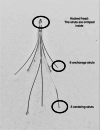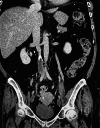A review of inferior vena cava filters
- PMID: 35856774
- PMCID: PMC10997026
- DOI: 10.1259/bjr.20211125
A review of inferior vena cava filters
Abstract
The care of patients with venous thromboembolism (VTE) is delivered via a multidisciplinary team. The primary treatment for VTE is anticoagulation; however, placement of filter devices in the inferior vena cava (IVC) to prevent embolisation of deep venous thrombosis (DVT) is a well-established secondary treatment option. Many controversies remain regarding utilisation and management of filters.
Figures







References
-
- Liu Y, Lu H, Bai H, Liu Q, Chen R. Effect of inferior vena cava filters on pulmonary embolism-related mortality and major complications: a systematic review and meta-analysis of randomized controlled trials. J Vasc Surg Venous Lymphat Disord 2021; 9: 792–800. doi: 10.1016/j.jvsv.2021.02.008 - DOI - PubMed
Publication types
MeSH terms
LinkOut - more resources
Full Text Sources
Medical

